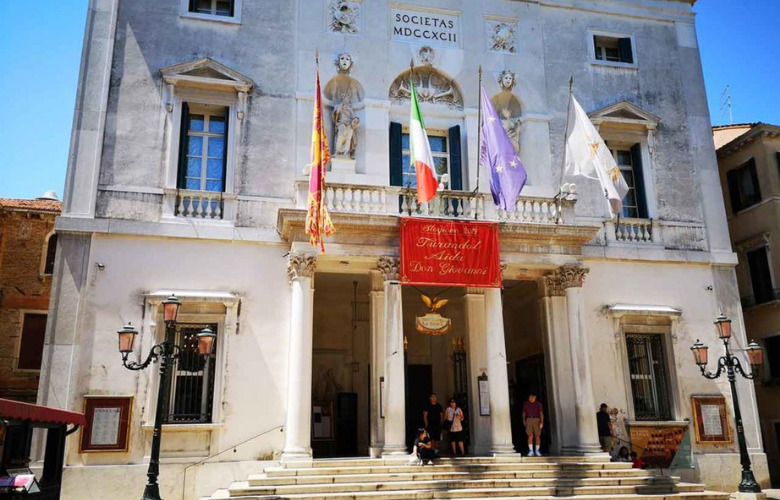
The Teatro La Fenice (meaning “The Phoenix”) is an opera house in Venice, Italy. It is one of the most famous and renowned landmarks in the history of Italian theatre, and in the history of opera as a whole. Especially in the 19th century, La Fenice became the site of many famous operatic premieres during which the works of several of the four major bel canto era composers – Rossini, Bellini, Donizetti, Verdi – were performed.
The Teatro La Fenice is probably the most beautiful opera house I have ever been to. These venues are all usually quite majestic, no matter where in Europe you go. But La Fenice has a special enchantedness about it.
Plus, due to the picturesque town it is located in, beautifully preserved Venice, you almost feel as if you have entered a time machine. And soon the high society of old is going to burst through the doors, all decked out in boisterous Rococo attire, bathed in ancient yet lavish perfume, to share the space with you.
La Fenice’s name reflects its role in permitting an opera company to “rise from the ashes” after being almost completely destroyed in a fire, not once, but three times thus far.
At the end of the eighteenth century, thanks to its long-standing historical and artistic tradition, Venice was the “Queen of Opera” and had no less than seven opera houses.
In 1754, due to an owner dispute over one of those houses, the Rossini Opera, which had burned down and then been rebuilt, the owners of Rossini Opera decided to build an 8th house.
La Fenice was the name of this new opera house which was inaugurated on 16 May 1792 with the opera I giochi di Agrigento by Giovanni Paisiello to a libretto by Alessandro Pepoli.
Ever since, La Fenice has stood out as one of the greatest opera houses in both Italy and Europe. And, thanks to the premieres of countless masterpieces, this house has become part of the history of melodrama.
Gioachino Rossini debuted at La Fenice on 6 February 1813 with Tancredi, his first ‘heroic’ masterpiece.
He was to write another two operas for La Fenice: Sigismondo (27 December 1815) and Semiramide (3 February 1823). One of the greatest of Rossini’s dramatic works and his last Italian opera before he moved to Paris.
Of Vincenzo Bellini’s ten operas, two were written for La Fenice: I Capuleti e i Montecchi (11 March 1830) and Beatrice di Tenda (16 March 1833).
Gaetano Donizetti, on the other hand, wrote three operas for the Venetian opera house: Belisario (4 February 1836), Pia de’ Tolomei (18 February 1837) and Maria de Rudenz (30 January 1838).
In the night between the 12th and 13th December of 1836, La Fenice was destroyed in a fire. However, the Company was not deterred and decided to go ahead with its reconstruction immediately.
This delicate task was entrusted to the hands of the brothers Giovanni Battista and Tommaso Meduna, both famous architects. While the equally delicate task of reconstructing the decorations fell to Tranquillo Orsi.
On the evening of 26 December 1837, just like the mythical Phoenix, La Fenice rose again in even greater beauty and splendour, continuing its path with renewed vigour.
In 1844, Verdi composed the first of the five operas La Fenice was to commission: Ernani (9 March 1844), Attila (17 March 1846), Rigoletto (11 March 1851), La Traviata (6 March 1853), and Simon Boccanegra (12 March 1857).
La Fenice is second only to La Scala in the number of Verdi premieres which have been performed there, including some of the great composer’s more audacious and experimental works.
Although La Fenice’s activity in the second half of the nineteenth century was conditioned by the political and economic crisis of the city, the opera house continued to thrive.
After the First World War, Teatro La Fenice was a hive of activity and renewed prestige, with the presence of singers such as Aureliano Pertile, Toti Dal Monte, Gina Cigna, and Tito Schipa. And conductors such as Guarnieri, Strauss, Reiner, Gui, Toscanini, and Mitropoulos.
Meanwhile, thanks to an initiative by the Art Biennale, the First International Festival of Contemporary Music was prepared and staged at La Fenice in 1930.
It marked the beginning of an institution which was to play a key role in the preservation and growing prestige of the opera house.
This with the creation of fundamental works in the history of twentieth century opera such as The Rake’s Progress by Igor Stravinskij (1951), The Turn of the Screw by Benjamin Britten (1954), The Fiery Angel by Sergej Prokofiev (1955), Intolleranza by the Venetian Luigi Nono (1961) and Hyperion by Bruno Maderna (1964).
After the second World War, Venice became a great centre of international tourism and La Fenice thus also an even more recognized, prestigious, international stage.
Singers such as Maria Callas, Renata Tebaldi, Giulietta Simionato, Franco Corelli, Alfredo Kraus, Joan Sutherland, Carlo Bergonzi, and from the ‘70s on Fiorenza Cossotto, Leyla Gencer, Luciano Pavarotti, Mirella Freni, Marilyn Horne, all performed at La Fenice.
Some of them more than once, together with conductors such as Serafin, Scherchen, Bernstein, Celibidache, Konwitschny, Stravinskij, Maderna, Karajan, Böhm, Abbado, Muti, and Prêtre.
Yet, in the evening of 29 January 1996, La Fenice was once again destroyed by a fire.
Teatro La Fenice was then rebuilt “as it was, where it was” in a project headed by the architect Aldo Rossi.
He also included the creation of new stage machinery and the reconstruction of the theatre services and administration offices, together with the philological reconstruction of the sale apollinee, the auditorium and the stage towers.
The greatly enhanced yet at the same time carefully reconstructed La Fenice was inaugurated on 14 December 2003, in the presence of the President of the Republic at the time, Carlo Azeglio Ciampi.
This also marked the beginning of a new Venice New Year’s Concert tradition.
Needless to say, throughout the year La Fenice continues to offer some of the finest opera performances you’ll have the privilege to experience in your lifetime.
Official Website Teatro La Fenice
La Fenice History on the Official Website
La Fenice on Wikipedia
On YouTube: Venice: Teatro La Fenice: Exploratory Tour:
Hidden Treasures: Beautiful Theatres in Malta
10 Strange Theatre Terms and Their Meanings


Liam Klenk was born in Central Europe and has since lived on four continents. Liam has always been engaged in creative pursuits, ranging from photography and graphic design, to writing short stories and poetry, to working in theatre and shows. In 2016, Liam published his first book and memoir, 'Paralian'.
Read Full Profile© 2021 TheatreArtLife. All rights reserved.

Thank you so much for reading, but you have now reached your free article limit for this month.
Our contributors are currently writing more articles for you to enjoy.
To keep reading, all you have to do is become a subscriber and then you can read unlimited articles anytime.
Your investment will help us continue to ignite connections across the globe in live entertainment and build this community for industry professionals.